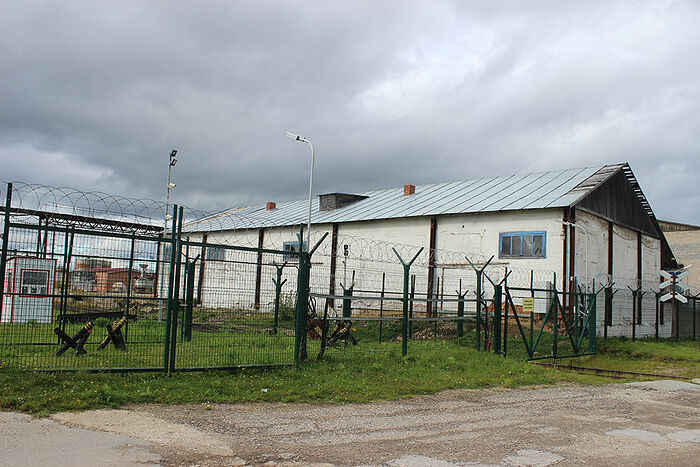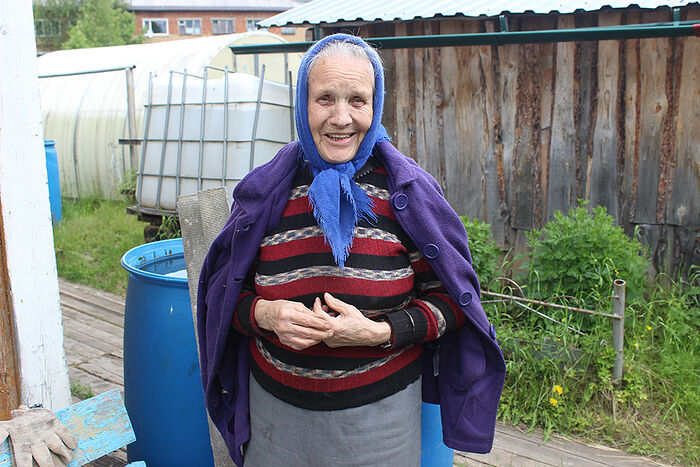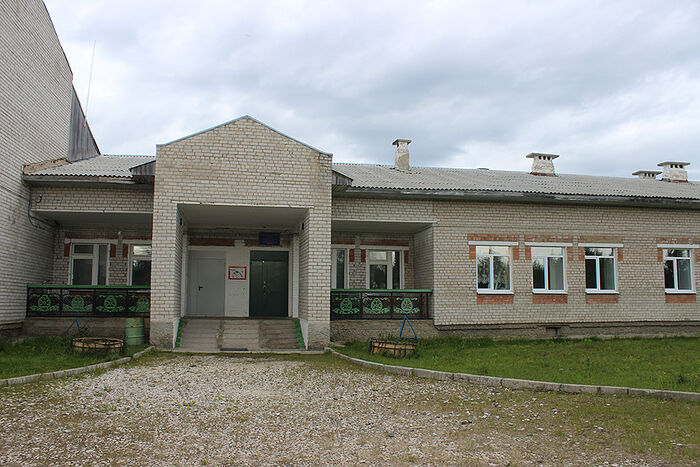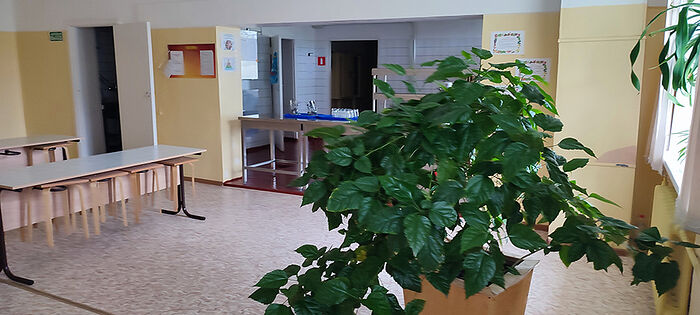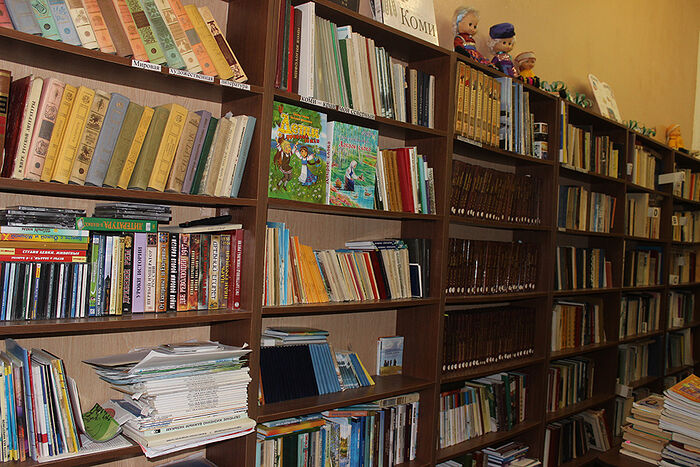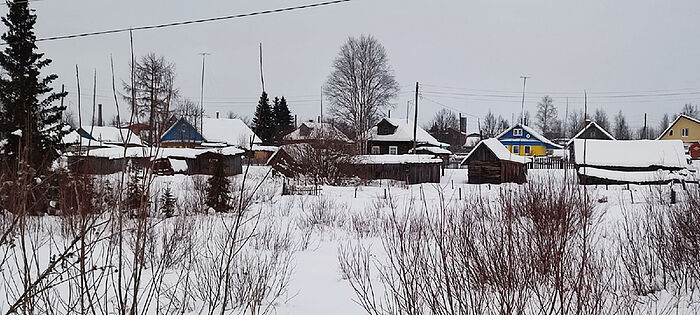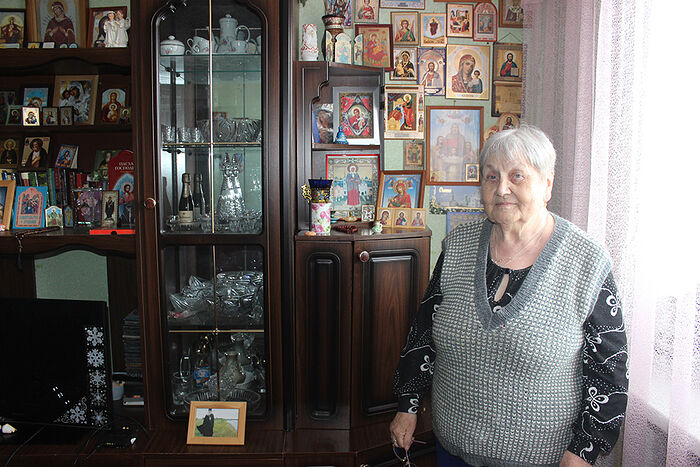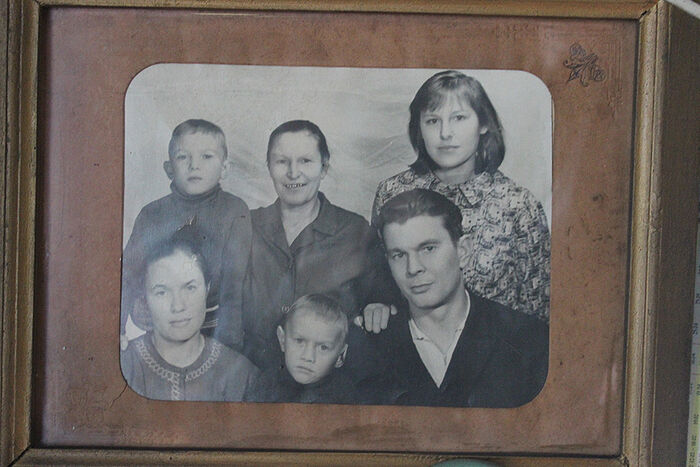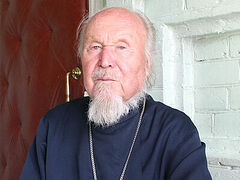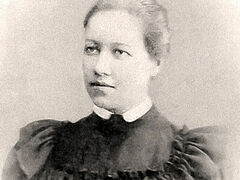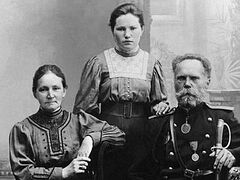The village of Naberezhny in Russia’s northern Pechora region arose essentially on the site of what was once a large cemetery—a cemetery of prisoners of the labor camps that built the Pechora Bridge and railway.
Over time, a settlement grew here, in which now nothing reminds one of the former island of the Gulag—there is no memorial plaque, no church, no chapel, not even a Pilgrimage Cross...
And the residents and guests of the Pechora region come to Naberezhny to capture at its main symbol—the Pechora Bridge, because it is located on the territory of this settlement, and therefore the best views of it can be photographed right here. Actually, that’s also why I came here once...
 The bridge over the Pechora River by Naberezhnaya
The bridge over the Pechora River by Naberezhnaya
Roads run everywhere
On the day of my arrival in the settlement, I was met by the head of the local House of Culture, Victoria Grigorishina, who gave me a one-hour tour of Naberezhny. We looked at the once city-forming enterprise—the Pechora oil depot. We also noticed that many houses are being built in the settlement—not summer cottages, but substantial ones, built on the principle of “my home is my fortress.” As Victoria Vladimirovna explained, many young families wish to settle in this picturesque corner of the Pechora district.
Although Naberezhny has a “river” name [naberezhnaya means “embankment”], it feels as though it’s entirely made up of railways—at least, during my walk around the settlement, I often had to walk over the tracks.
“This road leads to the Pechora oil depot; commuter trains run on it, which take us to Pechora. A ten-minute ride, and we’re in the city,” said my companion.
Another road and the Pechora Bridge connect the small settlement of Naberezhny with the whole of Russia! After visiting the hard-to-reach villages of the Pripetchorye region, I couldn’t help but think how lucky these people are, living by the river yet being able to reach anywhere by railroad. The main thing is, they appreciate what surrounds them and do not strive to leave their native settlement! Besides, the settlement has a House of Culture, a school, a kindergarten, and even its own medical facility.
You can see old houses in the settlement that are contemporaries of eighty-five-year-old Naberezhny. But what surprised me in Naberezhny were the well-maintained apartment buildings built by the Pechora oil depot for its employees.
As it turned out, there is also a museum room in Naberezhny, which was opened in the local House of Culture. The idea of its creation belongs to the creative residents of the settlement, Marina Ivanovna and Ekaterina Alexeyevna Arteyev, originally from the village of Ust-Tsylma, who brought a piece of their homeland to the settlement of Naberezhny, eventually creating a museum here. The basis of its exposition consists of household items used by the ancestors of the founders of this repository of history for centuries. And I was so impressed that all the exhibits are labeled!
 A museum corner in Naberezhnaya
A museum corner in Naberezhnaya
“It’s because guests often visit our museum,” Victoria Vladimirovna informed me.
In addition, the settlement’s cultural center operates seven clubs and the well-known and beloved folklore ensemble “Usttsylyomochka,” whose soloists are the founders of the museum in Naberezhny—Marina and Ekaterina Arteeva.
But then I went to Naberezhny, shared my journey on social media, took photos of the Pechora Bridge, and intended to stop there, because I didn’t find an interesting topic for my article here. But “trouble” was knocking on the door of the residents of Naberezhny.
“They are closing the school in the settlement! Help!”
After a while, educators and parents of the Naberezhny settlement school approached me asking for assistance in preserving the local school, which Pechora officials had decided to close. As I shared in one of my articles published on the Pravoslavie.Ru website, a journalist working in the northern hinterland is, in the understanding of its inhabitants, someone who can help solve a complex problem. So, I went to Naberezhny again, this time to meet with teachers, parents, and students of the school.
Then, for several months, I worked with the materials from this conversation and analyzed the work of the school, which, as I found out, is one of the best in the district. Teachers of this small “country of knowledge” participate in professional competitions—and win them; besides, the school successfully participates in grant competitions held by Lukoil [a large Russian oil holding]. And with prize money, it acquires equipment for ecological research, occupational experiments, and so on.
Morever, according to the results of a competition among educational institutions in the Komi Republic, the school cafeteria in the settlement of Naberezhny was recognized as one of the best.
The problem of the local “land of knowledge” was that in neighboring settlements, there were educational institutions where parents from Naberezhny increasingly began to send their children, believing that there the child would perhaps receive a better education. Consequently, their own local school began to lose students.
While I continued my work with the materials gathered during my visit to the school, I advised my protagonists to pray to the Mother of God, and here’s why.
A forgotten icon of the Mother of God “Quick to Hear”
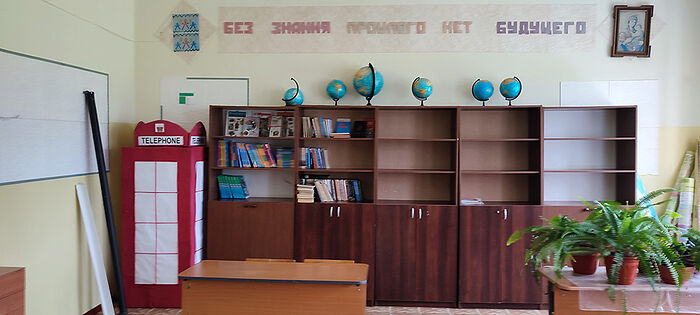 In one of the school rooms you can see a “Quick to Hear” icon of the Mother of God
In one of the school rooms you can see a “Quick to Hear” icon of the Mother of God
The thing is, the director of the educational institution, Vera Kokovkina, and the deputy director, Vera Galasheva, gave me a tour of the school, which recently celebrated its twentieth anniversary, meaning it’s a new and modern building. I visited beautifully decorated classrooms, a miniature library, which nevertheless has all the necessary literature, and a cozy cafeteria where even roses bloom.
When we arrived at the English language, history—and judging by the globes in the cupboard, geography—classroom with Vera Vladimirovna, I suddenly noticed among the school supplies an icon of the Mother of God, called “Quick to Hear.” As is known, there is a monastery in the city of Pechora dedicated to this icon of the Mother of God.
 The Naberezhnaya school principal, Vera Kokovkina
The Naberezhnaya school principal, Vera Kokovkina
“But why is it here, in the Naberezhny school?” I wondered.
“The thing is, this classroom used to house the school museum, and the icon remained from those museum times, despite the fact that the historical collection is now located in the House of Culture,” the principal explained.
And I told Vera Vladimirovna that people turn to this image of the Mother of God for help in their affairs if they are dictated by good intentions. The Mother of God hears each of us, and that’s why the icon is called “Quick to Hear,” meaning speedy hearing, prompt fulfillment of our requests. Therefore, I advised my companions to pray before this icon of the Mother of God for the preservation of the school.
And on September 1, the settlement’s “land of knowledge” opened its doors to its students! As of today, the work of the school in Naberezhny continues!
I also decided to continue my research work.
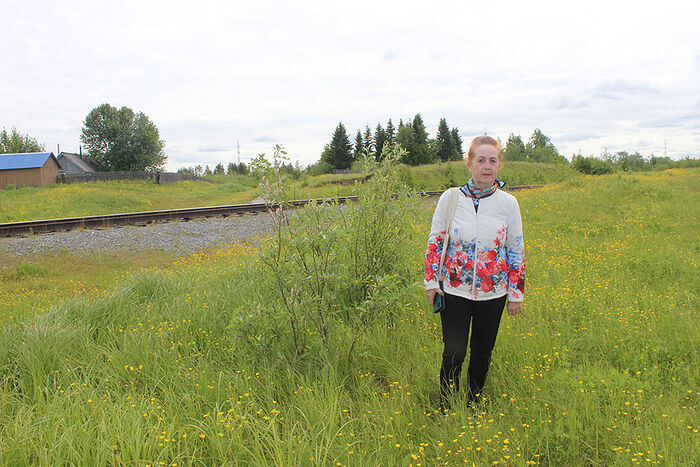 Liudmila Valentinovna Udovenko
Liudmila Valentinovna Udovenko
I also decided to continue my research work in the settlement, believing that my return here was not accidental. I asked Liudmila Udovenko, a teacher of the primary classes, to arrange meetings for me with longtime residents and Orthodox Christians of Naberezhny. Some came to talk in the medical center, while others invited me into their homes.
I was fortunate enough to visit the home of Naberezhny’s longtime residents and record their memories of the GULAG past of this wonderful corner of the Pripetchorye region.
From exile in the Komi Republic to building a family nest in Naberezhny
The memories of one villager, Nina Arteyeva, proved invaluable to me. However, as I found out, Nina Artemyevna originally came from the Kirov region.
“But how did you end up here, in the Komi Republic?” I asked during our conversation in the courtyard of her house.
“It’s a long story,” she smiles. “I was two years old when they brought me to this northern region in 1942. You see, my father went missing, and so my mother and I were sent to the North. My father was a participant in the Finnish war, and when World War II began he went to the front, and in 1942, he disappeared without a trace... Later they found my father, and my mother and I were allowed to return home. But there was nowhere to return to—our house was occupied by relatives. And we had no means to travel back to the Kirov region—we were brought here on horses! At that time, the railway had just opened, and the first freight train was dispatched. So the North became our home, and the Komi people welcomed us very warmly and kindly.”
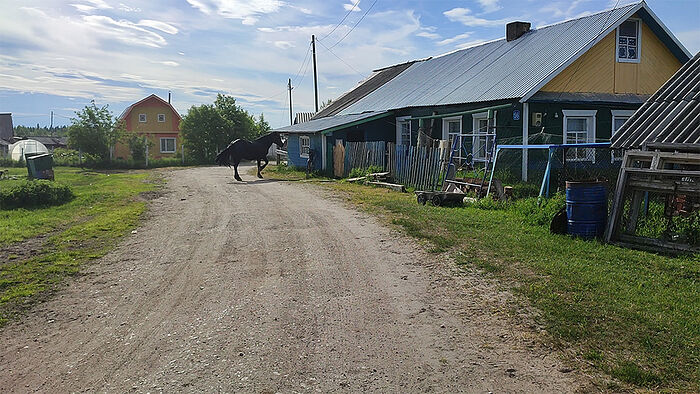 Before she settled in Naberezhnaya, Nina Artemyevna lived in Ust-Kozhva
Before she settled in Naberezhnaya, Nina Artemyevna lived in Ust-Kozhva
“Nina Artemyevna, do you remember others like you and your mother, who were exiles? What were these people like?” we continue our conversation.
“I don’t remember anyone by name anymore. People usually didn’t talk about being exiles. But they were very good and kind people,” she recalls warmly. “Soon after, my mother received my father’s death notice, then she received a second one. After some time, she remarried, and we moved to live in the village of Ust-Kozhva.”
Nina went to school in the present-day Naberezhny settlement, which is located near Ust-Kozhva. I was curious about what the settlement was like back then.
“There were graves all around the settlement,” Nina Artemyevna recalls. “And I saw one of the ass burials on what is now Pervomayskaya Street, and many unmarked graves at the turn, as you head towards our settlement. There were no crosses on the graves, just mounds.”
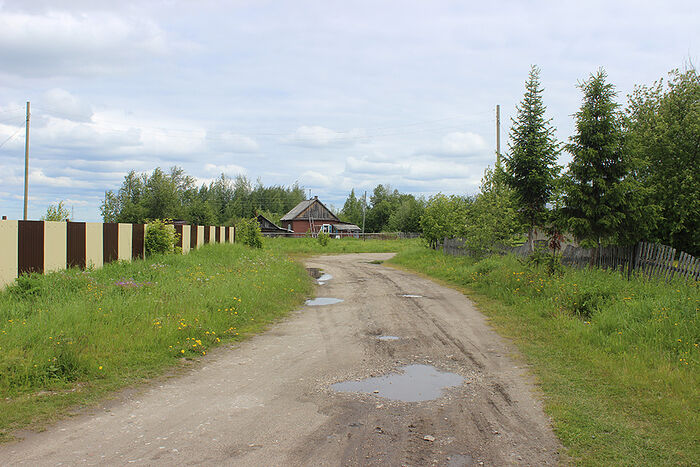 Here on the turn of the road, Nina Arteyeva saw unmarked grave mounds.
Here on the turn of the road, Nina Arteyeva saw unmarked grave mounds.
“Nina Artemyevna, how did you manage to remember such details if you were still a child at the time?”
“Well, we children ran around everywhere and saw a lot!” she explained.
Family Nest
Later, Nina Artemyevna moved to live in Naberezhny. While her husband was serving in the army, she managed to build a house here!
“And does the place where your house is built also have a sad history?”
Residents of Naberezhny told me stories of finding human bones when building their houses or digging plots.
“I can’t say anything about my plot. When I started building my house, there was still a forest here.”
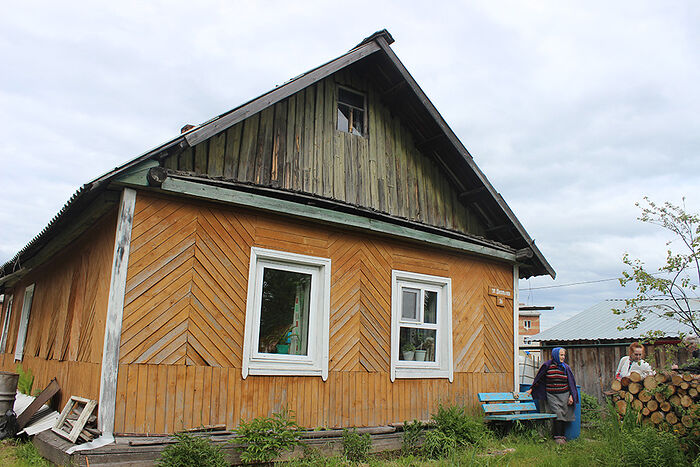 Nina Arteyeva’s house in Naberezhnaya
Nina Arteyeva’s house in Naberezhnaya
After such an enlightening conversation in the courtyard of her family nest, Nina Artemyevna invited us into her home for tea and relaxation. But I wasn’t in the mood for that. While examining old photos of her relatives displayed on the walls of the old house, I noticed the Gospel and the icon corners. Icons were everywhere in Nina Arteyeva’s house.
“Nina Artemyevna, besides being the keeper of Naberezhny’s history, are you also an Orthodox Christian?” I exclaimed.
“Yes! I’ve believed since childhood!” she continued, to my astonishment. “All my children, grandchildren, and great-grandchildren are baptized and Orthodox. Some were baptized in Malmyzh, a city in the Kirov region, and others in the church in the city of Klintsy, Bryansk region. And my mother, Agafya Alexeyevna, baptized me in one of the churches in the Kirov region when I was a child.”
About the Chapel in the Settlement
We also talked with Nina Artemyevna about the construction of a chapel in Naberezhny in memory of those killed during the years of repression in the camp. and the erection of a memorial cross.
“Oh, I don’t know...” she lamented. “Of course, it’s up to you, but I think... it’s unnecessary.”
Although she herself is a believer, Nina Artemyevna still believes that it is not worth building a chapel in the settlement with its Gulag past.
“Why?” I asked her, a little sadly.
“The kids nowadays, the teenagers! They’re not like we were. They don’t listen to anyone—not their parents, not their teachers. And they swear. They could start misbehaving in the chapel, and we’d have to guard the cross from them too,” clarified Nina Artemyevna.
“Because of all my housework, I often didn’t go to church.”
However, perhaps there’s another reason. Nina Artemyevna mentioned that she often didn’t go to church.
“I have three children, and there were six people living in our house altogether. We had to chop wood, wash clothes by hand for everyone. We would come home from work and rush to the store, and also gather supplies for the winter—picking mushrooms and berries. In the summer, I would go to the forest several times a day for mushrooms,” she said, to my amazement. “My husband and I managed to furtively hunt before the start of the workday, and after the end of the shift, we rushed to the forest as well. And on Saturday and Sunday, it was impossible to get me out of the woods. If I was collecting mushrooms in the nearby forest, I would fill one bucket after another and run home. That’s why there was no time left to visit the church, although a church opened in the 1990s not far from us in the neighboring village of Kozhva. There was also a church in the railway part of the city of Pechora. We baptized our grandchildren there.”
So, from my conversation with Nina Artemyeva I concluded that the residents of the settlement, which never had a church, have become accustomed to living without it.
Nadezhda Petrovna’s house church
During one of my visits to Naberezhny, I met Nadezhda Petrovna Gerasimovich. Nadezhda Petrovna is a deeply religious person who can no longer attend churches in other settlements of the district due to health reasons, so she arranged a kind of church... in her apartment!
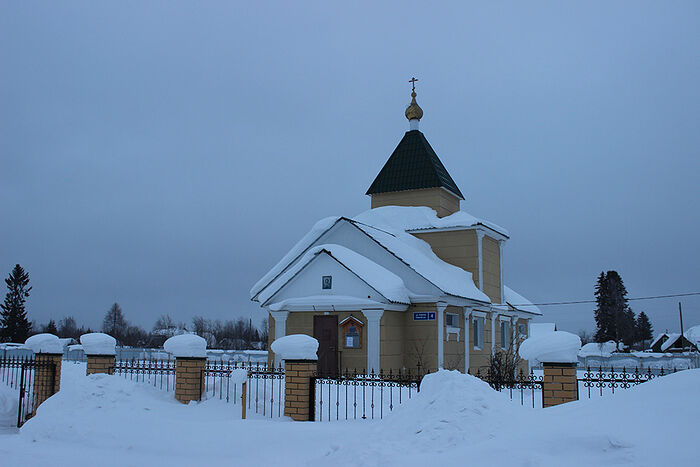 The Church of Holy Hieromartyr Herman (Ryashentsev)
The Church of Holy Hieromartyr Herman (Ryashentsev)
So, in the living room and in the kitchen, I saw icon corners; and in the hallway icons were everywhere—in closets, and on the shelves and walls. Nadezhda Petrovna explained, she mostly acquired holy images when she visited the “Quick to Hear” Mother of God Convent and churches in the city of Pechora and the neighboring settlement of Puteyets, which also has a church named after the Holy Hieromartyr Herman (Ryashentsev).
How long have you been a believer? we continued our conversation.
Since childhood. My grandmother, Tatiana Artyemova, was an Old Believer, and she lived in the village of Ust-Kozhva. That’s where I was born. And while my grandmother was alive, I lived with her and inherited my faith from her. I think my grandmother baptized me, although I can’t say for sure. I don’t remember.
Then, when I started attending the Orthodox church and told our Fr. Mikhail my story, he told me that I needed to convert to Orthodoxy, which I did, but at an advanced age.
“Why do you have so many icons in your house?”
“I love icons. I bought my first icon of Jesus Christ in the settlement at a time when a worker from the convent brought the holy icons to our Naberezhny,” she explained.
And so apparently Nadezhda Petrovna found a way out in the absence of a church in Naberezhny by creating a kind of house church in her apartment. But just the same, “If a church is built in our settlement, I will visit it every day,” the woman quietly remarked as we parted.
To be continued…

